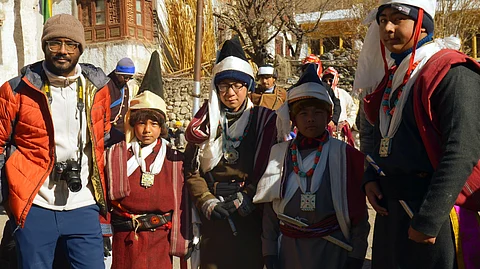
- Destinations
- Experiences
- Stay
- What's new
- Editor’s Picks
- Responsible Tourism
- CampaignsCampaigns
- Subscribe

On the third day of our expedition, we eagerly awoke, filled with anticipation, eager to confirm if the snow leopard siblings were still within sight. The previous evening had seen bets placed, with one spotter staking INR 2000 on the belief that the leopards would remain nearby.
Nevertheless, as Norbu scanned the mountains searching for the elusive Himalayan ghosts, his expression spoke volumes, dashing our hopes. His face revealed disappointment as all he managed to sight was a Himalayan Vulture perched on the remains of the carcass—what little remained after the snow leopards had finished their feast—and pecking at it.
"In nature's law, nothing goes to waste," remarked Norbu while seated on a stone, concluding his scan. "Initially, the apex predator like the snow leopard consumes the prime portions of its prey. Subsequently, wolves and foxes follow, known to devour even the skin. Finally, vultures and eagles complete the cycle by scavenging every last bit," he continued. "Now, we'll need to wait, whether for their next hunt or until we spot different ones elsewhere."
And thus concluded our rendezvous with the snow leopards. Though the thrill of sighting them and attempting to draw nearer had spanned a mere 24 hours, the image of their presence and the entire encounter would etch itself indelibly into our memories, lasting a lifetime.
Recognising our weariness and dwindling enthusiasm, Norbu—the group leader we needed—rose to his feet and declared, "It's Losar time in Ladakh. Let's head to a nearby village and enjoy the festivities." Dressed in our Columbia waterproof trekking pants and cosy fleece, providing an extra shield against the chilly weather, we set out.
Losar, derived from "Lo" for year and "Sar" for new, holds significant cultural importance in Ladakh. The festivities extend over 15 days, commemorating this Buddhist festival around the winter solstice period, typically occurring between December 8 and 30.
The celebration of Losar in Ladakh carries an intriguing tale. Legend has it that the King of Ladakh, Jamyang Namgyal, was gearing up for a confrontation with the forces of Baltistan. Advised by an oracle to delay the battle until the following year, the formidable ruler, instead, advanced the New Year (Losar) festivities by a month, celebrating it ahead of the usual date. As per historians, Losar's origins date to the introduction of Buddhism in Tibet, subsequently spreading to neighbouring nations like India, Bhutan, and Nepal, concurrent with the dissemination of Tibetan Buddhism and its practitioners.
Following a swift breakfast consisting of tea, scrambled eggs, and khambir (a round-shaped fermented dough baked over a hot stone), we settled into our car and set off towards Hemis Shukpachan, a village nestled in the Likir tehsil of Leh. Approaching the village, the melodic tunes of musical instruments, resembling something akin to shehnai and drums, echoed in the air, signalling the festivities.
We stepped into an enclosure roughly the size of a badminton court, sorrounded by traditional Ladakhi homes. The area bustled with local men, women, and children, many adorned in Goncha (a voluminous robe worn by males) and Sulma (a flowing traditional robe worn by females).
Everywhere one looked, individuals dressed in their finest attire exuded a sense of celebratory excitement, evident in the sparkle of anticipation gleaming in their eyes. Monks, adorning maroon robes, chanted mantras. The aroma of yak butter and roasted barley, the staple tsampa, made its way through the narrow lanes, mingling with the scent of burning juniper incense. Children, their faces flushed with excitement, darted between houses, giggling as they chased each other.
When I asked a group of local women about the details of Losar's preparations, one among them mentioned, "Before Losar arrives, we make sure our houses are spick and span, all neat and tidy for the festivities. We spend time preparing an array of delicious foods and dishes that we lovingly share with our dear ones throughout these special days of celebration."
Suddenly, a guttural yell cut through the air. The Losar King, resplendent in a feathered crown and white fur cloak, stepped into the enclosure, flanked by his masked entourage. The Chams (locals and monks in elaborately painted masks), their faces hidden behind masks, stomped, a kaleidoscope of colour and movement.
At the festival, I also witnessed Ladakhi Buddhists conducting religious ceremonies, presenting offerings to their deities, and engaging in a blend of age-old rituals and cultural spectacles through traditional performances. There were chants accompanied by flickering fire torches, symbolically depicting the eternal conflict between good and evil. Villagers clapped and cheered, their laughter echoing through the valleys, a symphony of joy against snow-capped peaks.
Soon after, families gathered, sharing hearty meals and exchanging stories. In the warmth of a sun-drenched courtyard, I, too, sat cross-legged with a Ladakhi family. Warm butter tea sloshed in my cup, its salty touch warming my numb fingers. They shared stories, tales of past Losars and hopes for the year ahead, the crackling fire painting flickering shadows on our faces.
"Losar isn't just about the festivities, you know. It's more like a magical time that goes beyond those celebratory days. It's a moment for self-reflection, a chance to cherish life's simple pleasures, and a time to come closer as a community," remarked Angchuk, the family patriarch, as I finished the last few sips of butter tea.
The echoes of laughter and music faded as I left the village. But the warmth of Losar, the tapestry of tradition and joy, will linger long after the last prayer flag flutters in the wind. It's a memory etched in the mountain air, a reminder that even in the harshest landscapes, the human spirit, like the flames of Losar, burns bright.
